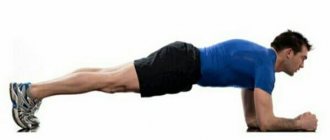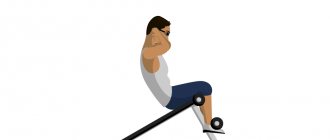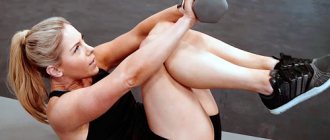Abdominal muscles need rest
First, let’s figure out whether it’s possible to pump up your abs every day or do you need to take a break?
First, I want to remind you of something that people often forget: the abs are the same muscles as any other in our body.
Like anyone else, they need time to recover.
Remember, during exercise you stress muscle fibers and even damage them to a mild degree. This damage is a good thing, because in response to it, the brain gives a command to build new, stronger and larger fibers that can withstand the increased load - this is called supercompensation.
Here you need to take into account that the recovery process does not occur during training, but after it.
Therefore, if you do not give your muscles time to recover after training, you will not get anything good from the training.
More doesn't mean better. And this rule applies to all muscles, not just the abs.
The harder a person works on his abs, the less time he gives his muscles to recover, the further his goal becomes, the slower his progress and the greater the likelihood of causing real damage to his body.
Abdominal exercises: useful tips
When it comes to questions about how many times a day you can pump your abs, and many others, experts give us the following recommendations:
- The rate of muscle growth does not depend so much on the number of repetitions of exercises. The result of 4 sets of 20 reps will be the same as 80 reps performed continuously, but it will exhaust you greatly.
- Remember the fat layer. If it is there, it will have to be removed using a special diet.
- The success of the workout will be indicated by a pleasant burning sensation in the abdomen. It indicates that the process of muscle growth has begun.
- The technique of doing the exercises is important. Only the right approach to them will help achieve results without harm to health.
- To prevent the muscles in the abdominal cavity from getting used to the load, you need to periodically change the exercises you perform. It is also important to alternate the work of the oblique abdominal muscles and the rectus muscle, working on both the upper and lower abs.
To achieve results, you need the right approach to exercise combined with proper nutrition. Also remember that you need to periodically increase the load - add exercises or approaches, because over time the same program will cease to be effective.
How long does it take to pump up your abs?
How often can you exercise your abdominal muscles?
If you don't want to overtrain your muscles, you need to know: how much is too much?
Some people advise working out your abs every day in order to quickly get the coveted 6-pack.
As you probably already guessed, I disagree with this statement. The abdominal muscles need to be given sufficient time to recover before being stressed again with grueling workouts.
There is another important fact to consider: the abdominal muscles recover faster than other muscle groups, simply because they work every day. They support your spine during any movement you make.
Even those who lead a sedentary lifestyle use their abdominal muscles on a regular basis. After all, these muscles not only give definition to the abdomen, but also work to keep a person upright and maintain balance and mobility in almost any human activity.
This means that the abs can be worked more often than any other muscle group.
But training every day is too often.
We are all different, and that is why it is difficult to answer the question of how often to train your abdominal muscles. There are many individual factors that will influence the answer, such as diet, lifestyle, fitness level and training style. All of them affect the speed of recovery.
I usually recommend at least 2 rest days per week. How to distribute these recovery days is a personal matter for everyone.
The most common training option includes classes every other day.
When gaining weight
In this case, you need to train your abs once or twice a week, using additional weight and heavy approaches. They, like any other muscle group, need a long rest after such volumes of loads.
This hard work builds a body frame that helps in other exercises and, of course, in life.
Exercise and subcutaneous fat
The choice of abdominal exercises also plays an important role.
You can do dozens of body lifts and twists, but still not get a visible result. Among other things, this approach can lead to back pain and muscle imbalance.
Instead, I recommended doing stability exercises that work the core muscles from all sides (planks, bird and dog exercises).
It is very important to get rid of fat deposits throughout the body, and not just on the stomach, only in this case the tummy will be prominent.
This is why isolated ab workouts don't work for fat loss.
Why?
The abdominal muscles are relatively small in size. They don't require a lot of calories to work properly, which means that training solely on your abdominal muscles won't have much of an impact on your overall body fat.
Such workouts will not even remove belly fat. And numerous studies provide direct confirmation of this.
You need to train so that fat is burned specifically around the working muscle, otherwise the body will break it down where and how it is convenient for it. The specific order and amount of fat the body uses is determined by gender, genetics, the presence of various chronic diseases and a number of other factors.
This doesn't mean that abdominal workouts are useless. These muscles are vital for performing all daily activities and maintaining balance. We need them to be strong.
And even if you don’t care about your strength, but only about the appearance of your abdominal muscles, then the first thing you will do is train these muscles.
Think about it:
If you lose all the excess fat but don't gain muscle, will your six pack still show?
No. You will simply have a flat stomach because without proper muscle training, they will not become noticeable.
Why is it harmful for women to pump up their abs?
You've probably noticed that many supporters of fitness weight loss just can't get rid of excess belly fat. Hence the popularity of miracle exercises, crazy cutting and magic diets. Some are trying to come to terms with the growing volumes and “accept them as they are,” others stubbornly go to the end, through laziness, back pain and tension in the neck they continue to pump their abs, often not suspecting that they are not only tormenting in vain , but also harm themselves.
Let's figure out why pumping up the press is not only useless, but even dangerous for women's health. Let's agree that in this material I will not analyze the psychosomatic or karmic reasons for increasing body size, but only what can be touched and checked. At the end of the text, I’ll tell you what exercises will help you tighten your stomach quickly and painlessly.
Fitness alert!
So, to make the stomach flat, we are offered mainly 2 exercises: raising the torso from a lying position and raising the legs, in different variations, the so-called upper and lower “crunches”.
During such twisting, pressure is created in the body, which can (and most often imperceptibly leads) to prolapse of the pelvic organs. I don’t want to scare you, but 90% of female diseases arise precisely because of organ prolapse - hence problems with the bladder, umbilical, inguinal hernia and other troubles. The point is in the structure of the muscles that envelop the pelvic area, the main one being the pelvic diaphragm. By nature, the pelvic diaphragm of men and women is organized differently. For a man, lifting weights, running, and lifting weights in the gym are really beneficial. And they are not dangerous: their pelvic diaphragm is fixed, the pelvic floor is tightly lined with muscles and there is no danger of organ prolapse. But for women it’s not like that. Our pelvic diaphragm is not fixed, because, according to the scenario, a child should appear from there. We do not have a dense muscle ring under the bladder and uterus. Our pelvis is more elastic and has an opening (vagina). Under pressure from lifting heavy weights, and even our own weight in crunches, we run the great risk of lowering our internal organs through our own actions.
But that is not all. “Steel” abs are not about health. In this case, the muscles lose their elasticity, and instead of supporting the internal organs, they seem to squeeze the torso. And during pregnancy, when the belly begins to grow, unable to stretch properly, the muscles tear - this is called diastasis or hernia of the white line. These consequences begin to appear by the age of 40-50.
In general, as far as women's fitness is concerned, the most useful things for us are swimming, walking, dancing, yoga, and Pilates. Therefore, if you, like me, are not very fond of working out in the gym, you are doing the right thing!
For some, the danger of harming themselves does not stop them on the path to a perfect body. Every third girl today dreams of becoming the queen of selfie-cutes. And then it’s worth thinking about the advisability of abdominal training, especially in a situation where, after several months of working with the body, the stomach is still there.
Go to Fedot
It happens that a person seems to be trying, spends 20 minutes every morning in training, but instead of gorgeous abs with the coveted six-pack, there is still the same fatty tummy.
Your back hurts and your neck hurts, even your facial muscles tense up when doing exercises. What's the matter? If you are familiar with a situation where, instead of pleasure from training, pain, a depressed emotional state and a feeling of inferiority appear, stop this useless activity. In our body, everything is somewhat more complicated than they say. There are connections, like highways, between systems: nervous, cardiovascular, muscular, digestive, and so on. There are main highways, and there are secondary ones. The main ones give orders, the secondary ones react.
You've heard more than once about consciousness and subconsciousness, right? That, they say, on a conscious level a person manifests what is hidden on the subconscious. It turns out it’s the same in the body. The subconscious of our body, according to many researchers, starting with Hippocrates, is the internal organs of a person. Moreover, recent research by Michael Gershon, a professor from New York (Columbia-Presbyterian Center) proves the presence of an intestinal brain in humans. So, the highway from the internal organs to the muscles in the professional environment is called the viscero-muscular connection. Each internal organ is associated, that is, connected to one or more muscles. For example, the liver is responsible for the pectoralis major muscle, the kidneys for the iliopsoas muscle, and the small intestine for the rectus and oblique abdominal muscles. The muscle will be strong or weak depending on the condition of the internal organ.
In this case, when it comes to abs, the following picture emerges. The person seems to be pumping his abs, but the abdominal muscles are not involved in this. The back, neck, face, anything but the rectus or oblique abdominal muscles become tense. And that means these movements are simply meaningless. Yes, you will get tired and spend calories, but you will not achieve an aesthetic effect. And to be completely honest, the rectus and oblique abdominal muscles, which most fitness exercises are designed for, do not need to be pumped, because due to the diaphragm, when inhaling and exhaling, the rectus abdominis is automatically pumped, contracting and stretching abdominal muscle. Obliques work during a step, when the “countermovement” of the arms and legs occurs. Moreover, the abdominal muscles are among the strongest because they need to support all the internal organs.
Verification by test
First, let's understand whether we need to do anything at all with our belly.
There is a simple test that will show you whether the abdominal muscles are involved in the work of the whole body: are they involved in walking, breathing, bending the body, or are their work performed by other muscles. Stand with a straight back, feet together. Place both hands on your stomach, do not press, but just feel it. Bend forward, trying not to suck in your stomach. And while bending over, feel what happened to your stomach: did it retract or did it seem to fall out into your hands? If the latter, then stop depressing yourself with training or even thinking about training. First, put the internal organs in order so that the small intestine includes the abdominal muscles in the general pattern of body movement. This can be done at home by doing two simple exercises.
First exercise
, despite the physical nature of this article, it will be rather metaphysical, because the state of the internal organs, stronger than the physiological aspects, is influenced by the emotional ones. The small intestine is also responsible for joy. More precisely, it begins to get sick and be capricious, like a small child, if there is no joy in the life of its owner. This means that you need to be happy at least once a day. How, to what, why - this is a topic for another article, but perhaps you already know all this, you just forget. Let me remind you that you now have a goal - a beautiful belly that requires joy.
Second exercise
quite physical, do it in any place and under any circumstances. Breathing in two phases. It improves not only the appearance of the abdomen, but also relaxes the thoraco-abdominal diaphragm and improves the functioning and connections between internal organs. Calms and straightens the spine. In general, a very useful exercise. We divide the inhalation into two phases. The first is from the lower abdomen, when we breathe, inflating the stomach like a balloon. The second is the diaphragm. To experience diaphragmatic breathing, place your hands on your ribs on the right and left. Feel how, as you inhale, your ribs move your palms apart, and as you exhale, they bring your palms together again. Make sure that the ribs open like an accordion, no longer upward, but to the sides. Exhalation - two phases, in reverse order. The ribs are compressed, the lower abdomen seems to be pulled up.
Try to do this exercise at least once a day for 1-2 minutes, and you will definitely find that within a week the volume will decrease by several centimeters. Tested personally, it works.
Biphasic breathing has no contraindications, even if serious health issues have already been diagnosed. I can’t promise that this alone will magically improve your condition. It happens that you need the help of a specialist or independent work with the stomach. In any case, remember what Albert Einstein said: “No problem is solved at the same level of consciousness at which it was created.” Love to study yourself, apply knowledge in practice, and then you will no longer have to undergo treatment.
Ekaterina Svyatkina is the founder of the Arhi Life Health Academy, a master of Abdominal Correction.
Photo: istockphoto.com
How to burn fat correctly?
To get rid of fat around your abdominal muscles, you need to focus on full-body strength training.
This may sound strange, but consider what we talked about earlier.
The most effective way to lose a few extra pounds is to do something that will burn a lot of calories, not to train a specific muscle group.
To burn a ton of calories in a short period of time, you need to concentrate on performing complex exercises for all muscle groups.
These are exercises like squats and deadlifts that use some of the largest muscle groups and some of the smaller ones to maintain balance and provide support.










